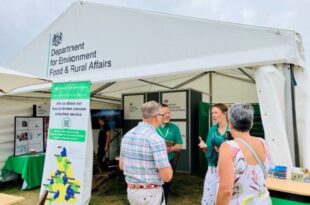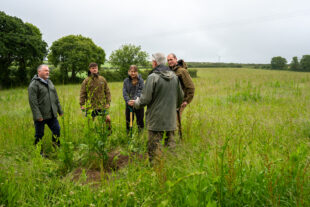https://defrafarming.blog.gov.uk/create-nesting-plots-for-lapwing-and-stone-curlew/
Create nesting plots for lapwing and stone curlew
The guidance on this page is for SFI pilot participants only. Please visit GOV.UK for the official Sustainable Farming Incentive scheme guidance.
Find out how land managers can provide nest sites for lapwing and stone curlew in arable crops.
If you’re completing this action as part of the Sustainable Farming Incentive pilot, how you do it is up to you.
The advice on this page can help you get better environmental and business benefits, but you do not have to follow it to get paid.
Lapwing and stone curlew nesting plots
Nesting plots are cultivated, uncropped areas in arable fields. They provide bare or thinly vegetated, open ground for lapwing and stone curlew to nest on.
Nesting plots are:
- simple and cheap to establish
- easily included in crop rotations
- habitats for insects, small mammals and other birds like yellowhammers
Use the Bird Atlas Mapstore to find out if lapwing or stone curlew nest in your area.
Provide invertebrate food alongside nesting plots, to help lapwing and stone curlew raise more chicks and increase the population.
Why lapwing and stone curlew need nesting plots
Lapwing and stone curlew have fallen sharply since the 1960s. This is partly due to a reduction in the number of safe nesting sites.
Nesting plots are important to help the recovery of these species. They have helped the English stone curlew population increase from around 150 pairs in the 1980s to an estimated 365 pairs in 2017.
Choose your location
Locate plots in fields where lapwing or stone curlew have nested before, or:
- in open fields larger than 5 hectares
- in open fields larger than 10 hectares, if woodland forms a quarter of the field boundary
- at least 100 metres away from trees and overhead power lines, as predators use them to look for prey
- at least 200 metres away from wind turbines
For stone curlew, keep plots in the same place every year if stone curlew nest on them.
For lapwing, you can move plots each year or keep them in the same place. Lapwing are more likely to use plots in fields next to grassland, like grazing marsh. They can use these areas to raise their chicks.
Avoid fields:
- with public rights of way, to reduce disturbance
- with severe weed problems, as the birds need open ground to see predators
- that are likely to flood during the spring and wash away nests
- at risk of soil erosion, as creating bare ground will cause more erosion
You must not create plots on historic features as cultivation will damage them.
When to create nesting plots
You’ll need to create nesting plots every year.
Your plots need to be ready by mid-February, in time for the first nesting attempts.
You can cultivate in March if the land is too wet in February.
In March, watch for any lapwing or stone curlew and leave the plot uncultivated if birds are already nesting on it. Avoid disturbing the plot if you see birds on it or circling over it.
Create your nesting plot
Create plots at least:
- 100 metres wide
- 1 hectare in area for lapwing
- 2 hectares in area for stone curlew
Cultivate to create a fallow area with a rough uneven surface, for nesting birds to hide in. For best results you should use:
- a spring tine cultivator
- a disc harrow
- a cultivator with press, not a pack roller or flexi-coil
- a plough with press
You do not need to cultivate plots that are already bare.
In February or early March, you can use herbicide to control weeds when they’re a few centimetres tall. Early weed control creates bare ground rather than a mat of dead vegetation.
Fertiliser and manure
Do not apply fertiliser or manure, as vegetation will quickly cover the bare ground that lapwing and stone curlew need to nest on.
How to manage nesting plots
Birds, nests and eggs are protected by law. Do not re-cultivate or spray herbicide if there are nesting birds.
Manage lapwing plots
Keep the plot bare or thinly vegetated until lapwing finish nesting at the end of July.
You can allow some vegetation to grow to provide cover and feeding habitat for chicks. Vegetation should cover no more than 70% of the plot at the end of April.
You can re-cultivate or use herbicide to clear vegetation if needed.
Keep your plots until lapwing have finished nesting.
Manage stone curlew plots
Keep the plot bare or thinly vegetated until stone curlew finish nesting at the end of September.
Check your plot to make sure vegetation covers no more than 60% of the area in early to mid-May.
You can re-cultivate or use herbicide to clear vegetation if needed.
Stone curlew have a long breeding season and will nest more than once. On the chalky soils of central-southern England, you’ll need to divide plots in 2 equal halves. Manage half the plot for the first brood of chicks and the other half for the second brood.
Cultivate or spray herbicide on only half the plot if vegetation cover is more than 60% in early to mid-May. This will allow you to maintain bare ground through the breeding season.
Keep your plots until stone curlew have finished nesting.
Stone curlew are very sensitive to disturbance. Humans can disturb them from up to 500 metres away. Specialist advice will help you monitor nesting birds and manage your plots, without disturbing birds, nests or chicks. Read more about stone curlew conservation from the RSPB.
You can allow local volunteers to monitor stone curlew nests and ring the chicks. Volunteers must have a Schedule 1 licence to approach stone curlew nests.
Control predators
You may see evidence that predators have attacked adults, chicks or eggs, meaning that low numbers of chicks fledge. You can use anti-predator fencing if nests are under threat, for example from foxes.
What good lapwing or stone curlew nesting plots look like
Good nesting plots will be bare or thinly vegetated for the whole of the nesting season.
Look out for lapwing circling over the plot in February and March, landing in the plots or sitting on nests.
Stone curlew are sensitive to disturbance, but you can watch them from further away using binoculars.



